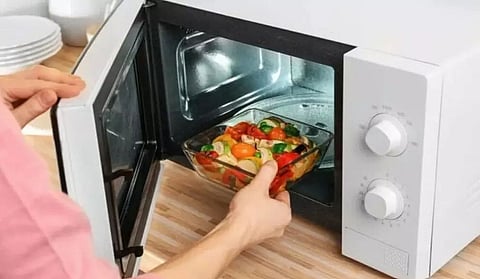
- Home
- Live Blog
- Breaking News
- Top Headlines
- Cities
- NE News
- Sentinel Media
- Sports
- Education
- Jobs

NEW YORK: Do you microwave food containers to heat your baby’s food and drink? It could be hazardous, warned a study. Experiments in the lab by researchers from the University of Nebraska-Lincoln showed that microwaving plastic baby food containers can release huge numbers of plastic particles — in some cases, more than 2 billion nanoplastics and 4 million microplastics for every square centimetre of container.
Though the health effects of consuming micro- and nanoplastics remain unclear, the Nebraska team further found that three-quarters of cultured embryonic kidney cells had died after two days of being introduced to those same particles.
A 2022 report from the World Health Organisation recommended limiting exposure to such particles.
“It is really important to know how many micro- and nanoplastics we are taking in,” said lead author Kazi Albab Hussain, a doctoral student in civil and environmental engineering at the University.
“When we eat specific foods, we are generally informed or have an idea about their caloric content, sugar levels, and other nutrients. I believe it’s equally important that we are aware of the number of plastic particles present in our food.
“Just as we understand the impact of calories and nutrients on our health, knowing the extent of plastic particle ingestion is crucial in understanding the potential harm they may cause. Many studies, including ours, are demonstrating that the toxicity of micro- and nanoplastics is highly linked to the level of exposure,” Hussain said.
Hussain and his team conducted experiments with two baby food containers made from polypropylene and a reusable pouch made of polyethylene, both plastics approved by the US Food and Drug Administration.
In one experiment, the researchers filled the containers with either deionized water or 3 per cent acetic acid — the latter intended to simulate dairy products, fruits, vegetables and other relatively acidic consumables, then heated them at full power for three minutes in a 1,000-watt microwave.
Afterward, they analysed the liquids for evidence of micro- and nanoplastics: the micro being particles at least 1/1,000th of a millimetre in diameter, the nano any particles smaller.
Based on a model that factored in particle release, body weight, and per-capita ingestion of various food and drink, the team estimated that infants drinking products with microwaved water and toddlers consuming microwaved dairy products are taking in the greatest relative concentrations of plastic.
Experiments designed to simulate the refrigeration and room-temperature storage of food or drink over a six-month span also suggested that both could lead to the release of micro- and nanoplastics.
The team then cultured and exposed embryonic kidney cells to the actual plastic particles released from the containers. Rather than introduce just the number of particles released by one container, the researchers instead exposed the cells to particle concentrations that infants and toddlers might accumulate over days or from multiple sources.
After two days, just 23 per cent of kidney cells exposed to the highest concentrations had managed to survive — a much higher mortality rate than that observed in earlier studies of micro- and nano plastic toxicity. The team suspects that kidney cells might be more susceptible to the particles than are other cell types examined in prior research. (IANS)
Also Read: Foods you should avoid reheating
Also Watch: